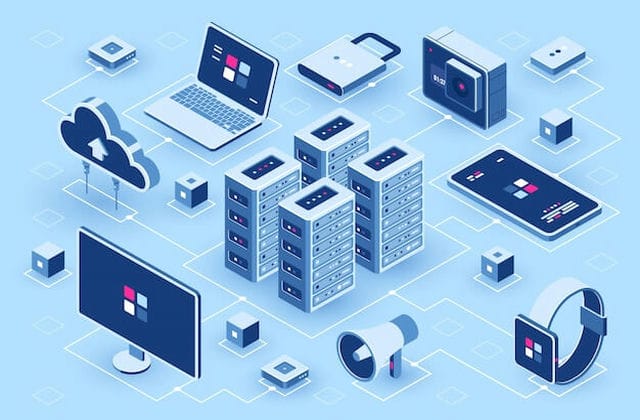For years, analysts have been anticipating the impact of the Internet of Things. However, there are two main obstacles to its success: capacity and security. 5G and blockchain technology are the key to solving these 2 major challenges.
But now, the introduction of new technologies could change that. This year, major operators such as AT&T and Verizon will launch the latest generation of cellular mobile communications, 5G. according to analysts, 5G platforms bring high data rates, shorter latency, energy savings, reduced costs, increased system capacity and massive device connectivity.
The combination of 5G and blockchain technology has the potential to unleash a surge in economic value. To understand this connection between 5G and blockchain, the relationship must be seen as multiple. By reducing latency, high speed and capacity, the power of the 5G overlay enables widespread use of IoT devices. At the same time, these devices can leverage the security, decentralisation, invariance and consensus arbitration of blockchain as a base layer.

This means that smart cities, driverless vehicles, smart homes and other sensor-driven enhancements will finally have the technology to meet their needs.
As the foundation layer, blockchain can provide consensus and security, while the majority of IoT transactions and contracts occur on the second layer of the network, with the opportunity to resolve payment channels and transaction disputes on the chain. However, the network capacity of the IoT will be achieved through the capabilities of 5G overlays.
In addition, 5G will directly assist the blockchain by increasing node participation and decentralisation, and allow for shorter blocking times, driving on-chain scalability - all of which in turn further supports the IoT economy.
Here's a first look at how 5G will be rolled out and when we could see it in action.
Rolling out 5G
Network providers have already started rolling out 5G in select US cities, while global coverage is expected to go live in 2020.
Verizon will begin operations in Chicago and Minneapolis on 11 April and will offer service to 30 cities for the remainder of 2019.
In terms of suppliers, Samsung is expected to release its 5G-compatible Galaxy S10 model next month. Other companies, such as Huawei and LG, have already announced their own models coming soon.
In terms of modems, we are still waiting for simultaneous support for 5G and LTE. Qualcomm is expected to release such a product, the X55, in the third or fourth quarter of this year.
Apple consumers will have to delay until 2020 before they see a 5G-compatible iPhone, and the company is clearly still assessing market conditions.
Waking up to the Internet of Things
The advantages of 5G are its high speed, capacity, low latency and the ability to connect to a large number of devices. Latency is the time between sending and receiving a signal. In blockchain terminology, latency is the time between a broadcast transaction and a node receiving it. However, for the IoT, whether applied to smart homes or self-driving cars, achieving low latency is critical if devices are to communicate with each other without experiencing long time lags.
This reduction can unlock another concept, the Internet of Skills (IoS). This is the process by which experts carry out their work remotely via a virtual reality headset. For example, a dentist can perform a procedure remotely. If delays are not minimised, then the specialist will not react adequately, endangering the patient and disrupting the entire function.
It is these new applications that are driving predictions of the economic impact of 5G. A Qualcomm study suggests that 5G could add $12.3 trillion to global GDP by 2035.
Importantly, 5G - with speeds of up to 10 gigabits per second - is an improvement on current home broadband services as well as cellular networks. To put this in perspective, the global average non-mobile internet speed is only 7.2 megabits per second. As a result, 5G is likely to become the de facto global interconnected network.
The impact of 5G on the Internet of Things and related concepts will be further enhanced by multi-access edge computing. This is a form of network where services are propagated from centralized nodes to peripheral nodes, resulting in even higher speeds, while also reducing latency.
The IoT will rely on this capacity and capability to connect large numbers of devices to each other. According to Huawei research, it is estimated that there could be up to 100 billion IoT connections by 2025, with growth likely to increase exponentially thereafter.
Accelerating automation
When talking about automation, it is common to think about robots replacing paid work currently done by humans. In reality, however, automation could eventually extend well beyond this to include the replacement of household chores and unpaid mundane tasks.
This can already be seen in the emergence of the smart home, with household appliances communicating with each other, keeping stock levels and managing inventory. Self-driving cars and trucks have already been tested, with legislation becoming the main obstacle.
Within the next decade, traditional industries - such as agriculture, mining and drilling - are all expected to be automated through the high-speed IoT, powered by billions of sensors and 5G+ communication devices.
Bottlenecks
These applications rely on extensive 5G coverage to provide the capacity, speed and latency required for these systems to perform as expected on a global scale.
However, two other potential 5G barriers could emerge.
Firstly, malicious devices may cause disruption in the network and be supported by its interconnectivity.
Secondly, the rollout of 5G will include an explosion of transactions and payments between these devices. These volumes could dwarf the capabilities of the current centralized and decentralised financial infrastructure.
Blockchain referees
Blockchain innovation may solve the first problem. Public, decentralised blockchains can ensure immutability, be tamper-proof and build consensus between untrusted entities.
As such, they could be used as a base layer for resolving disputes between IoT devices that cannot resolve the terms of transactions or smart contracts. As these devices can transact through money and operate vehicles, it is vital to establish an underlying protocol layer with strong security. Blockchain can excel in this regard.
Decentralised blockchains offer further advantages over the current client - server model used in IoT. Their decentralised architecture means that identities can be protected and guaranteed. Currently, IoT devices identify themselves via cloud servers and their identification data is stored in these databases. As a result, data can be compromised, stolen or imitated, presenting a major security threat to any application running on such a network.
By using a decentralised blockchain, we can protect these identities through the use of asymmetric encryption and secure hashing algorithms. Devices will be registered against their own corresponding blockchain address to secure their identity. This blockchain layer can provide a level of security and frictionless identification that cannot be matched by existing centralized infrastructures.
Scaling up
Unfortunately, the second problem of scale cannot be solved directly by blockchain. The absolute extent of the IoT means that decentralised blockchain architectures cannot handle the necessary throughput. This is at least as true at the first level - i.e. the blockchain itself.
It is possible and desirable to defer most transactions to a second layer protocol (such as a lighting network running on top of a blockchain) by using a payment channel or sidechain.
However, given that each device would need to have its own address and on-chain transactions, an on-chain capacity of tens of thousands of transactions per second would be required. In short, scalability must be significantly improved at both layers.
Blockchains such as Bitcoin Cash ABC, where block sizes are increasing, and Ether, through sharding, are building larger on-chain capacities. At the same time, we are seeing steady progress with the launch of the Lightning Network, and sidechains such as Liquid from Block stream, while the plasma network of Ether continues to advance. 5G and the expansion of Layer 2 blockchain infrastructure are happening at the same time by chance, providing the necessary scalability and reach for an IoT-oriented economy.
Another avenue for systems architects is to add other structures, such as graphs between the underlying blockchain layer and IoT devices. Designs such as directed acyclic graphs (DAGs) can be used to achieve higher throughputs. However, this often leads to compromised security and decentralisation.
Navigating the trilemma of scalability, security and decentralisation is a prerequisite for any blockchain-based IoT network, and deficiencies in any of these three areas could be disastrous for users and defeat the purpose of using such protocols in the first place. Until developers can produce alternative designs that achieve high throughput without sacrificing security or decentralisation, IoT networks will have to use more limited but secure blockchain structures.
Tamper-proof data
5G-empowered IoT devices will drive a significant increase in data transfer. Cisco's project that they will generate 847 zettabytes by 2021 Although its core blockchains are distributed data storage systems, it is not feasible to store significant amounts of on-chain data. However, if this IoT data is not stored on the chain then this would still leave it open to attack.
However, it is quite possible to store data hashes on the chain that link to external data storage sites that point to the entire data set. In practice, this external storage could run on other decentralised protocols such as Interplanetary File System (IPFS) or Orbit DB. while this does not guarantee the same level of tamper resistance, it does provide a stronger level of security than centralized alternatives. Importantly, by storing the hash on the chain, any tampering with the data will result in a change in the hash, raising concerns about such an attack, as well as a time record via timestamping.
Empowering smart contracts
Blockchains can also benefit directly from 5G in terms of functionality and performance.
One such example is smart contracts. Blockchain smart contracts often rely on oracles. These oracles pass external data to the contract. Of course, this information can only be transmitted via internet access. For applications such as supply chains, 5G can facilitate these oracles in remote areas where they would otherwise not be possible.

Network improvements
Blockchain can also benefit from the network improvements that 5G can provide.
Significant increases in range and bandwidth, as well as reduced latency aided by edge computing, could lead to a proliferation of additional nodes joining the public blockchain. By extending coverage to remote areas and providing more connectivity to non-static devices such as mobile devices and tablets, network participation can be significantly increased, leading to improved security and decentralisation.
In addition, with reduced latency, developers can make more attempts to reduce blocking times, thereby increasing on-chain throughput. In turn, this will provide better support for IoT devices that use the blockchain for settlement, consensus and security.
Multiple relationships
To truly understand the value of 5G, IoT and blockchain, you must see them as synergistic rather than offering completely separate value propositions. With the right architecture, this technology stack - along with Layer 2 solutions, edge computing, virtual reality, augmented reality and IoS - will create unprecedented value while fundamentally changing working conditions, employment and entertainment.





























